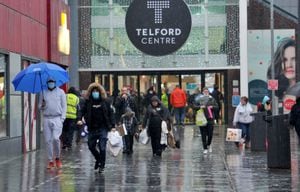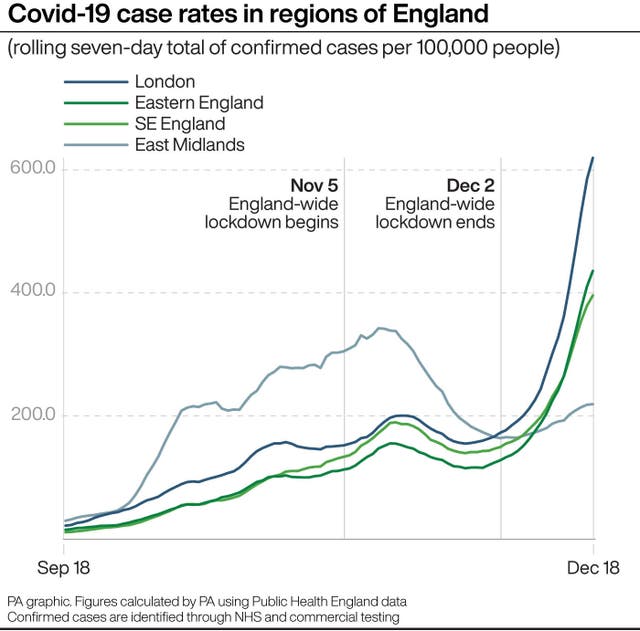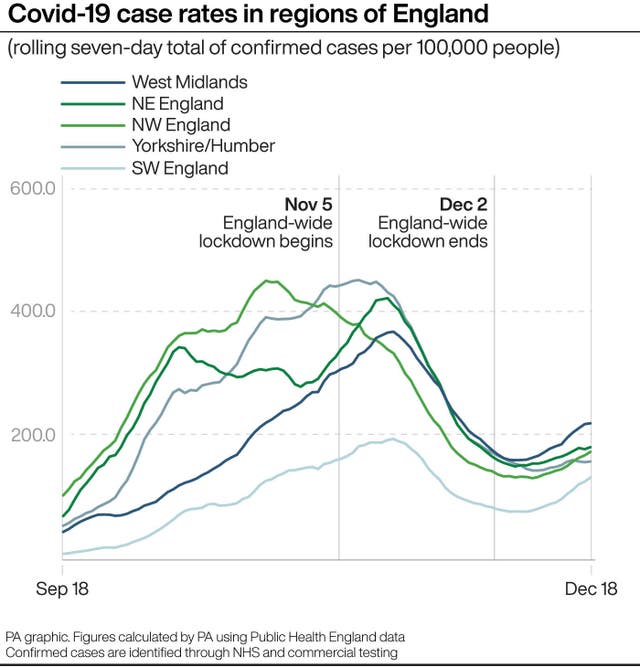UK Covid tiers: What tier am I in, what's changed and what are the rules?
Millions more people across the south east and east of England are to be moved into the toughest Tier 4 restrictions from Boxing Day as the number of Covid-19 cases spread.

The West Midlands is staying unchanged - meaning the Black Country, Birmingham and Staffordshire stay in Tier 3 while Telford and Shropshire stay in Tier 2.
But health Secretary Matt Hancock has also said that two cases of another new strain of Covid-19 linked to South Africa have been identified in the UK.
More details were given at a Downing Street press conference on the current situation with the coronavirus pandemic.
Scroll down for answers to the key questions and details of which areas will be in which tier from Boxing Day.
– Which areas are being moved into Tier 4?
Sussex, Oxfordshire, Suffolk, Norfolk and Cambridgeshire, those parts of Essex not yet in Tier 4, Waverley in Surrey and Hampshire including Portsmouth and Southampton but with the exception of the New Forest will move into Tier 4 from 00.01am on Boxing Day.
– Are any other areas of England being moved into a tougher tier of Covid 19 safety restrictions?
Bristol, Gloucestershire, Somerset including the North Somerset council area, Swindon, the Isle of Wight, the New Forest and Northamptonshire plus Cheshire and Warrington are moving up to Tier 3.
Cornwall and Herefordshire which have seen “sharply rising rates” are moving up to Tier 2, Mr Hancock announced.
– Why are these changes being made now?
All the new measures are being imposed against a backdrop of increasing infections, hospital admissions and a new more contagious variant in the UK which was announced on Friday.
Mr Hancock said Covid-19 is spreading at a “dangerous rate” across large parts of England and it is “better to act sooner”.
Mr Hancock said that Tier 3 “is not enough to control the new variant” and the number of cases have been rising in areas which are near to sites which are already in Tier 4 restrictions.

More of the East and South East of England are going into Tier 4 as East Anglia has seen “a significant number of the new variant and we’ve seen case rates rise sharply”, Mr Hancock said.
There are also “some early signs” of the new variant and rising cases in the South West which also now faces tougher restrictions.
– What is known about the new strain from South Africa?
Both are contacts of cases who have travelled from South Africa over the past few weeks.
Mr Hancock described this new variant as “highly concerning” as it is “yet more transmissible and it appears to have mutated further than the new variant that has been discovered in the UK”.
– What is being done to try and contain this new strain?
Those with the new strain of the virus along with anyone who has been in close contact with them have been quarantined.
Immediate restrictions have been imposed on travel from South Africa and the Government is telling those who have been in contact with anyone who has been there in the last fortnight to quarantine.
Further investigation into this new strain are set to take place at Porton Down.
– What is happening about vaccinations?
Vaccinations have begun in care homes.
Mr Hancock said the Pfizer/BioNTech vaccine is being delivered in more than 500 sites across the UK, including care homes, with more to follow.
He added that the Chelsea Pensioners are being vaccinated, along with care home residents right across the country on Wednesday afternoon.
– Are there any developments on the testing programme?
There are 116 local areas which have signed up for community testing.
Mr Hancock called the rapid tests “extremely effective” at finding cases.
A further £149 million is being used to boost rapid testing in care homes.
Anyone who works in care homes in England will receive two rapid tests a week, in addition to their weekly PCR tests.
Which areas are in which tiers?
– Tier 4
A total of 24 million people will be living in Tier 4 from 12.01am on Saturday December 26.
This is 43% of the population of England.
Some six million people were added to Tier 4 in Wednesday’s briefing in the following areas:
Cambridgeshire: Cambridge, East Cambridgeshire, Fenland, Huntingdonshire and South Cambridgeshire
East Sussex: Brighton & Hove, Eastbourne, Lewes and Wealden
Essex: Colchester, Tendring and Uttlesford
– Hampshire: Basingstoke & Deane, East Hampshire, Eastleigh, Fareham, Hart, Rushmoor, Southampton, Test Valley and WinchesterNorfolk: Breckland, Broadland, Great Yarmouth, King’s Lynn & West Norfolk, North Norfolk, Norwich, South Norfolk
Oxfordshire: Cherwell, Oxford, South Oxfordshire, Vale of White Horse and West Oxfordshire
Suffolk: Babergh, East Suffolk, Ipswich, Mid Suffolk and West Suffolk
Surrey: Waverley
West Sussex: Adur, Arun, Chichester, Crawley, Horsham, Mid Sussex and Worthing
These areas join Bedfordshire, Berkshire, Buckinghamshire, Peterborough in Cambridgeshire, Hastings and Rother in East Sussex, the rest of Essex, the rest of Hampshire, Hertfordshire, Kent, London and the rest of Surrey, which are already in Tier 4.
The main restrictions in Tier 4 are:
No household mixing allowed, though one person can meet one other person outside in a public space
All non-essential shops and businesses must close, including personal care and indoor entertainment
Nobody can enter or leave Tier 4 areas
Residents must not stay overnight away from home
– Tier 3
Some four million people will be moved to Tier 3 from December 26, bringing the total in Tier 3 to 25 million people, or 44% of the population of England.
The areas moving into Tier 3 are:
Bristol
Cheshire: Cheshire East, Cheshire West & Chester and Warrington
Gloucestershire: Cheltenham, Cotswold, Forest of Dean, Gloucester, Stroud and Tewkesbury
Hampshire: Isle of Wight and New Forest
Northamptonshire: Corby, Daventry, East Northamptonshire, Kettering, Northampton, South Northamptonshire and Wellingborough
Somerset: Bath & North East Somerset, Mendip, North Somerset, Sedgemoor, Somerset West & Taunton and South Somerset
Swindon
These areas join Derbyshire, County Durham, South Gloucestershire, Greater Manchester, the Humber, Lancashire, Leicestershire, Lincolnshire, Northumberland, Nottinghamshire, South Yorkshire, Staffordshire, Tees Valley, Tyne & Wear, Warwickshire, the West Midlands metropolitan county and West Yorkshire, which remain in Tier 3.

The main restrictions in Tier 3 are:
No household mixing allowed indoors or outdoors, except in parks and public gardens<
All hospitality is closed, except for takeaways and deliveries
All accommodation and entertainment venues are closed
– Tier 2
The number of people living in Tier 2 will fall to seven million, or 13% of the population of England.
Two areas have been moved from Tier 1 to Tier 2: Cornwall and Herefordshire.
They join Cumbria, Devon, the Liverpool City Region, North Yorkshire, Rutland, Shropshire, Wiltshire (not including Swindon), Worcestershire and York, which remain in Tier 2.

The main restrictions in Tier 2 are:
No household mixing allowed indoors, but the “rule of six” applies outdoors
Hospitality venues must close unless serving substantial meals with drinks
Large sport and entertainment events are allowed but with a very limited audience
– Tier 1
Just 2,000 people will be in Tier 1 from December 26 – the population of the Isles of Scilly.
The main restrictions in Tier 1 are:
The “rule of six” must apply indoors and outdoors
There must be table service in hospitality venues, with last orders at 10pm and closing time at 11pm
Large sporting and entertainment events are allowed but with a limited audience.





